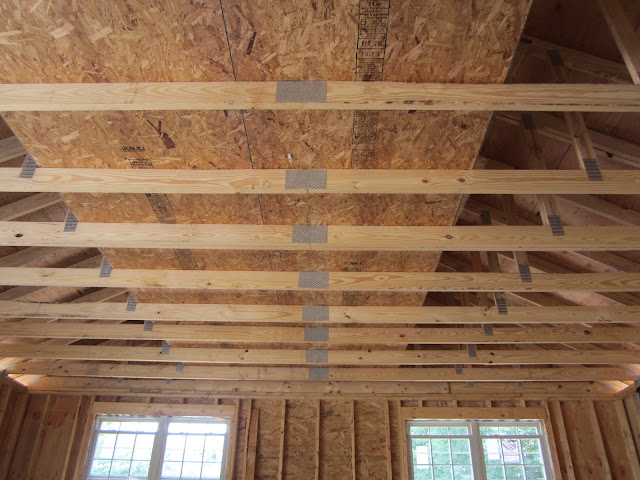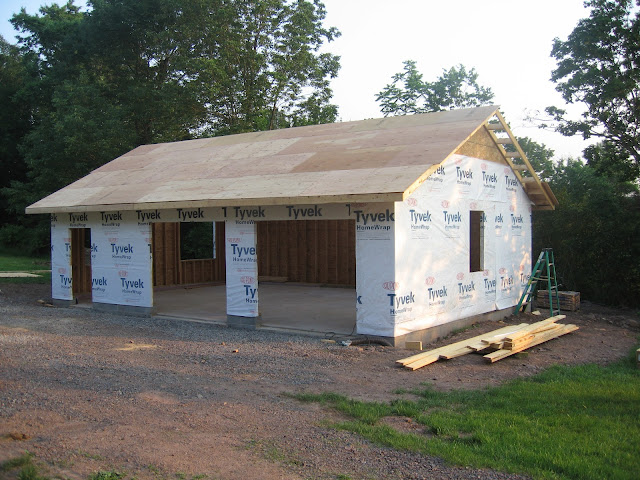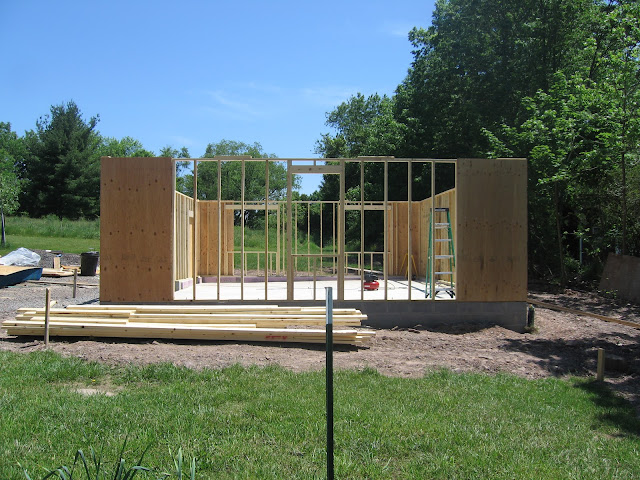The roof is done! This week is supposed to have a few rainy days and I'm enjoying the thought of that rain falling...outside the garage.
I used GAF/Elk Barkwood dimensional (architectural) shingles to match the house. It ended up being a little less than 13 square (that is 1300 SF) with the 18" eves and the dormer.
When I priced the shingles I saw Lowes had them for about $36/bundle (3 bundles = 1 SQ, so $108/SQ). My local roofing/siding supply house (Roslyn Supply) had them for $92.50/SQ.
The GAF shingles are now called Timberline HD. They used to be called Timberline Prestique 30. Same product. They've started saying that their 30 year shingles have a "lifetime" warranty, but my understanding is that's only the case if installed by an authorized GAF installer using all GAF products.
Part way through the roof, I was thinking that the shingles felt pretty flimsy...and I went to get one of the shingles that I had used on the house in 2004. The quality difference was notable - the old shingle was much heavier. I can't remember for sure, but I believe I got what's now called Timberline Ultra HD last time. If I were doing a house I think I would go for the Ultra again - the thickness difference is significant.
What did I use:
- Drip Edge - 180' (18 pieces)
- Ice/Water Shield - (2) 67' rolls with probably 30' left over.
- 15# tar paper - (3) 432SF rolls (I always thought 30# was better because it was heavier, but I read that it's better to use 15# because it allows moisture to escape more easily. 30# should only be used if you need to leave the tar paper exposed for an extended time)
- 1-1/4" Roofing Nails - 1 box of 7200.
- shingles - 36 bundles
- ridge cap shingles - 3 bundles, but I barely needed the 3rd bundles and that was just because of the dormer
- 1/4 staples - 2 boxes of 1750.
- step flashing - about 14 pieces
- starter shingles - 2 bundles (it's definitely cheaper/easier to buy starter shingles then to 'make' them from standard shingles)
- gunable ridge vent - (2) 20' rolls
Problems:
- Wind - seems like we had few spells of high winds during the time when I had tar paper down, but not yet shingles. At first, I tried to staple sparingly to keep from puncturing the waterproof surface too much, but after the wind ravaged the tar paper a few times, I stapled the heck out of it.
- Wrinkles in tar paper - I'm not sure if there is a trick to getting wrinkle-free 15# paper laid. Seems like if it goes through an over night, with the dew & change of temp, it ends up with lots of wrinkles. They calm down when it warms up again, but it's still a bit of a bother when snapping chalk lines. Even big wrinkles were not at all visible through the shingles...which I had read could be an issue.
- Hot weather - As I noted the shingles that I used seems pretty thin - especially when they were even a bit warm. I took care not to walk on the roof once it had been in the sun for a while. If it was an 80 degree day and there was direct sun, I tired to avoid working on it.
Notes:
- If you use drip edge, the starter shingles and first course of shingles can be flush with the edge of the drip edge.
- If you don't use drip edge, overhang the shingles (starter and 1st course) 1".
- Lay the first course, then measure up from the top edge of the shingle in increments of the overlap amount. In my case, it was 5-5/8". Since I was doing this measurement a lot, I put pencil marks on my tape measure - that was nice.
- I've heard that some people lay the shingles and let them hang off the roof and come back and cut them all off later. I cut mine one at a time and I think that works best - especially with thicker shingles.
- The bundles wrappers have pretty nice instructions on them.
Enough writing - how about a few photos.
Jen took some photos from the upstairs window.
Me chucking a ruined piece of tar paper off the roof. (see the "problems" section)
At this point the back was complete about as far up as the front. As described in the "problems" section, I would work on the front early in the day and then switch to the back when the front got too warm.
The order of application is: drip edge along the eves, tar paper, drip edge along the gable ends,
starter shingles, shingles. Since I was doing this by myself I used nails at one end to snap the chalk lines. I only snapped about 20' of line - after that the line sagged a bit.
I cut my ridge vent into the sheathing as I was laying the sheathing. Then, as I laid the tar paper and shingles, I kept cutting out the ridge vent. I think some people snap a line and cut right through everything after the roof is laid.
Weaving the valley was interesting. I wanted to be sure that there was adequate material in the valley so I cut the shingles off 6" up the opposite side of the valley. I think I could have done it with less material, but I wasn't sure where it was "safe" to cut corners. Also, all this overlapping created a slight lump that ran on either side of the valley...but it's something that you can't see unless you look very closely - definitely can't be seen from the ground. My other rule was no nails within 6" of the valley.
And here it is done. Ready for rain!
Next up: windows & doors! I'm going to decide on the design of the dormer windows once I see what the garage door windows look like installed.




















































